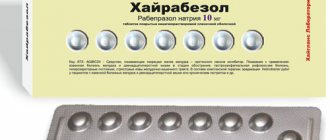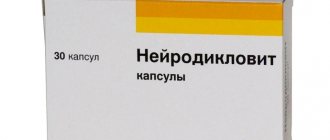Razo, 10 mg, enteric-coated tablets, 30 pcs.
The patient's response to rabeprazole therapy does not exclude the presence of malignant neoplasms in the stomach.
Razo® tablets should not be chewed or crushed. The tablets should be swallowed whole. It has been established that neither time of day nor food intake affects the activity of rabeprazole.
In a special study in patients with mild or moderate hepatic impairment, the incidence of side effects of rabeprazole was not found to be significantly different from that of age- and sex-matched healthy subjects, but despite this, caution is recommended when first using rabeprazole in patients with severe impairment liver functions. The AUC of rabeprazole in patients with severe hepatic impairment is approximately two times higher than in healthy patients.
No dosage adjustment of rabeprazole is required in patients with impaired renal or hepatic function.
Hypomagnesemia
When treated with proton pump inhibitors for at least 3 months, cases of symptomatic or asymptomatic hypomagnesemia have been reported in rare cases. In most cases, these reports were received one year after therapy. Serious adverse events included tetany, arrhythmia, and seizures. Most patients required treatment for hypomagnesemia, including magnesium replacement and discontinuation of proton pump inhibitor therapy. In patients who will be receiving long-term treatment or who are taking proton pump inhibitors with drugs such as digoxin or drugs that can cause hypomagnesemia (eg, diuretics), healthcare providers should monitor magnesium levels before starting treatment with proton pump inhibitors and during treatment.
Patients should not take other acid-reducing agents, such as H2 blockers or proton pump inhibitors, at the same time as rabeprazole.
Bone fractures
Observational studies suggest that proton pump inhibitor therapy may increase the risk of osteoporosis-related fractures of the hip, wrist, or spine. The risk of fractures was increased in patients receiving high doses of PPIs for a long time (a year or more).
Concomitant use of rabeprazole with methotrexate
According to the literature, simultaneous use of PPIs with methotrexate (primarily in high doses) can lead to increased concentrations of methotrexate and/or its metabolite hydroxymethotrexate and increase the half-life, which can lead to methotrexate toxicity. If high doses of methotrexate are required, temporary discontinuation of PPI therapy may be considered.
Clostridium difficile
PPI therapy may lead to an increased risk of gastrointestinal infections such as Clostridium difficile.
Patients taking rabeprazole for short-term symptomatic treatment of symptoms of GERD and NERD (eg, heartburn) without a prescription should contact their doctor if:
- use of medications to relieve symptoms of heartburn and indigestion for 4 weeks or more;
- the appearance of new symptoms or a change in previously observed symptoms in patients over 55 years of age;
- cases of unintentional weight loss, anemia, bleeding in the gastrointestinal tract, dysphagia, pain when swallowing, persistent vomiting or vomiting with blood and epigastric contents, cases of stomach ulcers or gastric surgery in history, jaundice and so on (including , impaired liver and kidney function).
Patients suffering from recurring symptoms of indigestion or heartburn for a long time should be monitored regularly by a doctor. Patients over the age of 55 who take over-the-counter medications daily to relieve symptoms of heartburn and indigestion should tell their healthcare provider.
Patients should not take other acid-reducing agents, such as H2 blockers or proton pump inhibitors, at the same time as rabeprazole.
If using other medications, patients should consult their pharmacist or physician before starting therapy with over-the-counter rabeprazole.
If the patient is already scheduled for an endoscopic examination, the patient should consult with a physician before using rabeprazole without a prescription.
Rabeprazole should be avoided before a urease breath test.
Patients with severe hepatic impairment should consult a physician before initiating over-the-counter rabeprazole therapy for short-term symptomatic treatment of manifestations of GERD and NERD (eg, heartburn).
Razo®
Cytochrome 450 system
Rabeprazole, like other proton pump inhibitors (PPIs), is metabolized by the cytochrome P450 (CYP450) system in the liver. In
vitro
studies with human liver microsomes have shown that rabeprazole is metabolized by the isoenzymes CYP2C19 and CYP3A4.
Studies in healthy volunteers have shown that rabeprazole has no pharmacokinetic or clinically significant interactions with drugs that are metabolized by the cytochrome P450 system, warfarin. phenytoin, theophylline and diazepam (regardless of whether patients are extensive or poor metabolizers of diazepam).
A study of combination therapy with antibacterial drugs was conducted. This four-way crossover study involved 16 healthy volunteers who received rabeprazole 20 mg. 1000 mg amoxicillin. 500 mg clarithromycin or a combination of these three drugs (RAK - rabeprazole, amoxicillin, clarithromycin). AUC and Cmax values for clarithromycin and amoxicillin were similar when combination therapy was compared with monotherapy. AUC and Cmax for rabeprazole increased by 11% and 34%. respectively, and for 14-hydroxy-clarithromycin (the active metabolite of clarithromycin), AUC and Cmax increased by 42% and 46%, respectively, for combination therapy compared with monotherapy. This increase in exposure rates for rabeprazole and clarithromycin was not considered clinically significant.
Interactions due to inhibition of gastric acid secretion
Rabeprazole provides a stable and long-lasting suppression of gastric juice secretion. Thus, interactions may occur with substances for which absorption is pH dependent. When taken simultaneously with rabeprazole, the absorption of ketoconazole is reduced by 30%, and the absorption of digoxin is increased by 22%. Therefore, some patients should be monitored to determine whether dose adjustments are necessary when rabeprazole is coadministered with ketoconazole, digoxin, or other drugs for which absorption is pH dependent.
Atazanavir
When atazanavir 300 mg/ritonavir 100 mg was coadministered with omeprazole (40 mg once daily) or atazanavir 400 mg with lansoprazole (60 mg once daily) in healthy volunteers, a significant reduction in atazanavir exposure was observed. Absorption of atazanavir is pH dependent. Although concomitant use with rabeprazole has not been studied, similar results are expected for other proton pump inhibitors. Therefore, concomitant use of atazanavir with proton pump inhibitors, including rabeprazole, is not recommended.
Antacids
In clinical studies, antacids were used in conjunction with rabeprazole. No clinically significant interactions of rabeprazole with aluminum hydroxide gel or magnesium hydroxide were observed.
Eating
In a clinical study, no clinically significant interactions were observed when rabeprazole was administered with a low-fat meal. Taking rabeprazole simultaneously with a fat-enriched diet may slow down the absorption of rabeprazole by up to 4 hours or more, but Cmax and AUC do not change.
Cyclosporine
In
vitro experiments using
human liver microsomes showed that rabeprazole inhibits the metabolism of cyclosporine with an IC50 of 62 µmol, i.e. at a concentration 50 times the Cmax for healthy volunteers after 20 days of administration of 20 mg rabeprazole. The degree of inhibition is similar to that of omeprazole for equivalent concentrations.
Methotrexate
Based on adverse event reports, published pharmacokinetic studies, and retrospective analysis, it may be suggested that concomitant use of PPIs and methotrexate (primarily at high doses) may result in increased concentrations of methotrexate/or its metabolite hydroxymethotrexate and prolong the half-life. However, no specific drug interaction studies have been conducted between methotrexate and PPIs.
Special instructions for the use of the drug Razo
Before starting treatment, it is necessary to exclude the possibility that the patient has malignant neoplasms, since treatment with rabeprazole may mask symptoms and delay correct diagnosis. The drug is not prescribed to children, since there is no experience of its use in pediatric practice. Prescribe with caution to patients with severely impaired liver and kidney function. If drowsiness occurs, it is necessary to refrain from driving vehicles and/or operating other mechanisms that require increased concentration and speed of psychomotor reactions.
Pharmacological properties of the drug Razo
Rabeprazole is an antiulcer agent. The mechanism of action is associated with inhibition of the specific enzyme H+/K+-ATPase in the parietal cells of the gastric mucosa. Rabeprazole, as an inhibitor of the gastric proton pump, blocks the final stage of hydrochloric acid formation. This action, depending on the dose, leads to inhibition of both basal and stimulated secretion of hydrochloric acid, regardless of the nature of the stimulus. The drug does not have anticholinergic properties and does not block H2 receptors. After oral administration, it is quickly and completely absorbed into the gastrointestinal tract. The antisecretory effect develops within 1 hour after oral administration at a dose of 20 mg. The maximum decrease in gastric pH is recorded 2–4 hours after the first dose. A stable antisecretory effect develops 3 days after the start of treatment. Absolute bioavailability is 52% due to primary passage through the liver. The bioavailability of rabeprazole does not increase with multiple doses. Food intake and timing of administration throughout the day do not affect the absorption of rabeprazole. Plasma protein binding - 97%. Metabolized in the liver with the participation of enzymes of the cytochrome P450 system. About 90% of rabeprazole is excreted in the urine, mainly in the form of metabolites, the remainder is excreted in the feces.
Razo
Razo ®
(lat. Razo ®) - a drug that normalizes gastric acidity, a proton pump inhibitor, a generic rabeprazole. A significant argument in favor of prescribing generics has always been their lower cost compared to the cost of the original drug, but they do not always have the proper biological, pharmaceutical and therapeutic equivalence to the original drug. Produced by Razo®, it combines the high clinical effectiveness of the original drug, safety of use, economic accessibility and high production standards in accordance with GMP criteria, registered by the FDA in the Orange Book in category AB (Kazyulin A.N., Goncharenko A.Yu).
Proton pump inhibitors (in particular, rabeprazole) are considered the most effective drugs for controlling symptoms and treating complications of GERD, such as reflux esophagitis and Barrett's esophagus (see Fifth Moscow Agreement // XIII Congress of the National Registry, March 12, 2013).
Dosage forms of Razo
Active substance Razo: rabeprazole.
Razo is available in two versions of enteric-coated tablets containing 10 and 20 mg of rabeprazole. Type of tablets: round, biconvex. 10 mg tablets are pink with the inscription “RB10” in black. 20 mg tablets are yellow, with the inscription “RB20” in red. Excipients of Razo tablets and their shells: mannitol, low-substituted hyprolose, heavy magnesium oxide, hypromellose (5 cps), sodium lauryl sulfate, talc, magnesium stearate, zein, triethyl citrate, methacrylic acid copolymer (type C), triethyl citrate, talc, hypromellose 6 cps , titanium dioxide, macrogol 400, shellac glaze, butanol, iron oxide dye (yellow, coaxial and black), isopropanol, butanol, propylene glycol, concentrated ammonia solution.
Indications for use Razo
Razo is indicated for:
- erosive reflux esophagitis
- nonerosive gastroesophageal reflux disease
- long-term maintenance therapy of gastroesophageal reflux disease
- Zollinger-Ellison syndrome
- peptic ulcer of the stomach and duodenum in the acute stage
- for the eradication of Helicobacter pylori
in patients with diseases associated with Helicobacter, such as peptic ulcer of the stomach and duodenum, chronic gastritis, low-grade MALT lymphoma, prevention of stomach cancer (in justified cases) - as part of complex therapy
How to take Razo and dosage
Razo tablets are taken orally, whole, without chewing or splitting into parts. The duration of therapy and dose depend on the indications.
- Patients with gastric and duodenal ulcers in the acute stage, erosive reflux esophagitis, and with symptomatic treatment of gastroesophageal reflux disease take Razo 20 mg once a day, in the morning. Initially, the duration of therapy is determined for patients:
- with a stomach ulcer at 6 weeks
- with duodenal ulcer - 4 weeks
- with erosive reflux esophagitis - 4 weeks
Depending on the course of the disease, the doctor may double the duration of Razo therapy.
- For patients requiring long-term maintenance therapy, the daily dose can be set at 10 or 20 mg depending on the body’s response.
- Symptomatic treatment of GERD without esophagitis: daily dose - 10 mg for a month, then, if symptoms occur - 10 mg once a day, as required
- Zollinger-Ellison syndrome. The recommended starting dose of Razo for adult patients is 60 mg per day, with possible increases to 120 mg per day depending on the individual needs of the patient. A daily dose of up to 100 and a dose of up to 100 mg can be taken once a day. A large dose requires dividing it into two doses. The duration of treatment is determined by the patient's condition.
To treat Helicobacter pylori-associated diseases,
Razo and other rabeprazole drugs are used in combination with several antibiotics. For example, Razo at a dosage of 20 mg + clarithromycin preparation 500 mg + josamycin preparation 1000 mg per day or nifuratel 400 mg; this complex of drugs is prescribed for administration 2 times a day for 10-14 days. The use of double doses of Razo increases the effectiveness of three-component therapy (see Fifth Moscow Agreement // XIII Congress of the NOGR. March 12, 2013).
Use of Razo during pregnancy and breastfeeding
The FDA Fetal Risk Category for Razo (rabeprazole) in pregnant women is C* (animal studies have shown adverse effects on the fetus and there have been no adequate studies in pregnant women, but the potential benefits associated with the use of this drug in pregnant women may justify its use despite the risks involved).
During treatment with Razo, you should stop breastfeeding.
Note. *Previously, before the 2014 change, rabeprazole was category B.
Resources for Healthcare Professionals
Articles
- Kazyulin A.N., Goncharenko A.Yu. Choice of proton pump inhibitor during Helicobacter pylori eradication therapy. Maastricht V // Russian Journal of Journalism. — 2021. — No. 10. P. 712–717.
- Pakhomova I.G. A multimorbid patient with GERD and pathology of the cardiovascular system receiving antiplatelet therapy. Possibility of choosing a proton pump inhibitor using a clinical example. Medical advice. 2019;(14):10-16.
On the website GastroScan.ru in the “Literature” section there is a subsection “Rabeprazole”, containing medical articles devoted to the treatment of diseases of the gastrointestinal tract with drugs containing the active substance rabeprazole.
Video
| Simanenkov V.I. Acid suppressive therapy for refractory forms of GERD | |
| Kaibysheva V.O. Personalized approach to the diagnosis and treatment of GERD | |
| Bordin D.S. Errors in diagnosis and treatment of GERD | |
| Kareva E.N. Could a patient's genetic makeup be the cause of refractory GERD? Pharmacogenetic management of PPI effectiveness | |
| Tsukanov V.V. Rational choice of PPI for a comorbid patient with GERD | |
| Alekseenko S.A. GERD complicated by pathology of ENT organs, diagnostic possibilities | |
| Pakhomova I.G., Novikova D.S. Management of comorbid patients in outpatient settings. Opinion of specialists: cardiologist and gastroenterologist | |
| Vyalov S.S. Reflux secretion |
On the website in the “Video” section there is a subsection “For Doctors”, containing video recordings of reports, lectures, webinars in various areas of gastroenterology for healthcare professionals.
Other medicines containing the active ingredient rabeprazole
In Russia, the following drugs with the active ingredient rabeprazole are registered for sale in pharmacies: Bereta, Zolispan, Zulbex, Noflux, Ontime, Pariet, Rabeloc, Rabeprazole-OBL, Rabeprazole-SZ, Rabiet, Hairabezol.
In the USA and several other countries, Pariet is sold under the brand name AcipHex.
In a number of countries - former republics of the USSR, medicines with the active substance rabeprazole produced by Macleods Pharmaceuticals Ltd, India, are registered, in particular: in Kazakhstan
- Rabemak 10 and Rabemak 20,
in Ukraine
- Rabimak (Ukrainian rabіmak), as well as Rabelok (Ukrainian Rabelok) produced by Cadila Pharmaceuticals, Ltd., India. In addition, in the pharmaceutical markets of countries - former republics of the USSR, there are a number of other drugs with the active substance rabeprazole, not registered in Russia, in particular: Barol-20 (Themis Laboratories Pvt. Ltd., India), Geerdin - powder for the preparation of solution for injection and enteric-coated tablets (Mepro Pharmaceuticals, India and Mili Healthcare Ltd, UK), Rabezol (Med-Interplast, India), Rabeprazol-health (Ukraine), Razol-20 (Biogenics Limited, India) and others.
general information
According to the pharmacological index, Razo belongs to the group “Proton pump inhibitors”.
According to ATC, it belongs to the group “Proton pump inhibitors” and has the code A02BC04. Manufacturer Razo - (Dr. Reddy's), India.
The drug Razo is included in the FDA Orange Book (Pakhomova I.G.), which lists drugs registered based on the results of confirmation of safety and effectiveness by the US Food and Drug Administration (FDA).
Available in pharmacies with a prescription.
Razo has contraindications, side effects and application features; consultation with a specialist is necessary
.
|
| Booth of Dr. Reddy's dedicated to the drug Razo. Gastroweek 2017, Moscow (photo by S.S. Tarasova) |
Back to section
Razo drug interactions
Rabeprazole causes a powerful and long-lasting decrease in the secretion of hydrochloric acid in the stomach, and therefore can affect the kinetics of drugs whose absorption depends on the acidity of the gastric contents. When taken simultaneously with ketoconazole, rabeprazole causes a decrease in its concentration in the blood plasma and increases the minimum concentration of digoxin. Therefore, patients taking these drugs in combination with Razo should be under medical supervision to determine the need for individual dosage adjustments.




